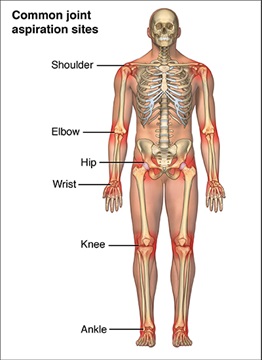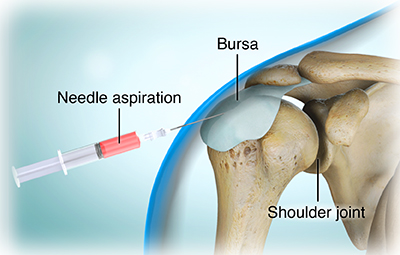How To Get Fluid Out Of Knee
Joint Aspiration
What is joint aspiration?
Joint aspiration is a procedure to remove fluid from the space around a joint using a needle and syringe. This is usually done under a local anesthetic to relieve swelling and/or to obtain fluid for analysis to diagnose a joint disorder or problem.
Joint aspiration is most often done on the knee. However, fluid can also be removed from other joints, such as the hip, ankle, shoulder, elbow, or wrist.

Other related procedures that may be used to help diagnose joint problems include X-ray, bone scan, magnetic resonance imaging (MRI), computed tomography (CT scan), arthroscopy, and arthrography. Please see these procedures for additional information.
Why might I need a joint aspiration?
Joint aspiration may be done to diagnose and assist in the treatment of joint disorders and/or problems. By analyzing the fluid, the following conditions may be diagnosed:
-
Gout
-
Various types of arthritis
-
Joint infection
Joint aspiration can also be done to remove a large collection of fluid around a joint. Sometimes bursitis (inflammation of the bursa) causes fluid to collect near a joint. Removing the fluid will decrease the pressure, relieve pain, and improve movement of the joint. Sometimes, a medicine is injected following removal of the fluid to help treat tendonitis or bursitis.
There may be other reasons for your healthcare provider to recommend a joint aspiration.
What are the risks of a joint aspiration?
As with any surgical procedure, complications can happen. Some possible complications may include:
-
Discomfort at the aspiration site
-
Bruising at the aspiration site
-
Swelling at the aspiration site
-
Infection at the aspiration site
There may be other risks depending on your specific medical condition. Be sure to discuss any concerns with your healthcare provider before the procedure.
How do I get ready for a joint aspiration?
-
Your healthcare provider will explain the procedure to you and offer you the chance to ask any questions that you might have about the procedure.
-
You will be asked to sign a consent form that gives your permission to do the procedure. Read the form carefully and ask questions if something is not clear.
-
Tell your healthcare provider if you are sensitive to or are allergic to any medicines, latex, tape, and anesthetic agents (local and general).
-
Tell your healthcare provider of all medicines (prescribed and over-the-counter) and herbal supplements that you are taking.
-
Tell your healthcare provider if you have a history of bleeding disorders or if you are taking any anticoagulant (blood-thinning) medicines, aspirin, or other medicines that affect blood clotting. It may be necessary for you to stop these medicines before the procedure.
-
If you are pregnant or suspect that you are pregnant, you should notify your healthcare provider.
-
Generally, no prior preparation, such as fasting or sedation is needed.
-
Based on your medical condition, your healthcare provider may request other specific preparation.

What happens during a joint aspiration?
A joint aspiration may be done on an outpatient basis or as part of your stay in a hospital. Procedures may vary depending on your condition and your healthcare provider's practices.
Generally, a joint aspiration procedure follows this process:
-
You will be asked to remove clothing and will be given a gown to wear.
-
You will be positioned so that the healthcare provider can easily reach the joint that is to be aspirated.
-
The skin over the joint aspiration site will be cleansed with an antiseptic solution.
-
If a local anesthetic is used, you will feel a needle stick when the anesthetic is injected. This may cause a brief stinging sensation.
-
The healthcare provider will insert the needle through the skin into the joint. You may feel some discomfort or pressure.
-
The healthcare provider will remove the fluid by drawing it into a syringe that is attached to the needle.
-
The needle will be removed and a sterile bandage or dressing will be applied.
-
The fluid sample will be sent to the lab for examination.
What happens after a joint aspiration?
Once you are home, it is important for you to keep the joint aspiration site clean and dry. Leave the bandage in place for as long as instructed by your healthcare provider.
The aspiration site may be tender or sore for a few days after the joint aspiration procedure. Take a pain reliever for soreness as recommended by your healthcare provider. Aspirin or certain other pain medicines may increase the chance of bleeding. Be sure to take only recommended medicines.
Notify your healthcare provider to report any of the following:
-
Fever of 100.4°F (38°C) or higher, or as directed by your healthcare provider
-
Redness, swelling, bleeding, or other drainage from the aspiration site
-
Increased pain around the aspiration site
Your healthcare provider may give you additional or alternate instructions after the procedure, depending on your particular situation.
How To Get Fluid Out Of Knee
Source: https://www.hopkinsmedicine.org/health/treatment-tests-and-therapies/joint-aspiration
Posted by: sandlinbervelp82.blogspot.com

0 Response to "How To Get Fluid Out Of Knee"
Post a Comment